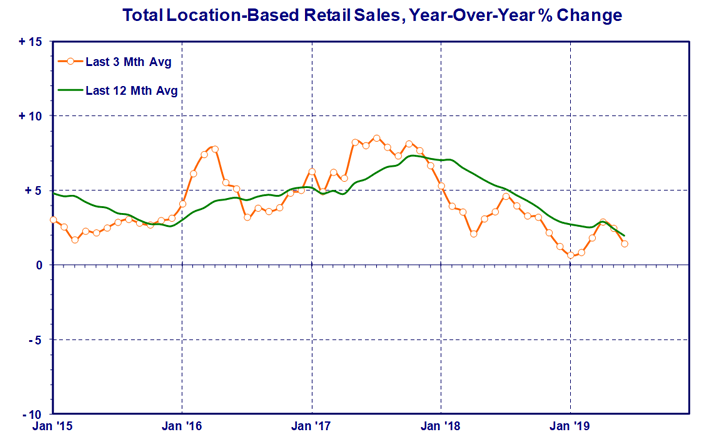Canadian Retail Sales Growth Weakens Again: Expert
/By Ed Strapagiel
After a year of unrelenting declines, Canadian retail sales growth may have finally hit bottom. But it’s too early to tell when things will perk up. Here’s my updated analysis.
The latest numbers from Statistics Canada show that overall retail sales growth in Q2 2019 was just 1.5% year-over-year on a not seasonally adjusted basis. This was even lower than the dismal 1.8% increase for Q1 of the year, although both are slightly ahead of the 1.3% gain recorded for Q4 2018. All these low growth rates are less than price inflation plus population growth and should not be sustainable, but you never know.
The 3 month sales growth trend (orange line in the chart above) and the underlying 12 month trend (green line) showed some recovery earlier in the year, but this has turned out to be a red herring. Both trends are now weakening and there doesn't appear to be much cause for optimism moving forward. Automotive & Related is the main drag on total retail sales, but other retail sectors are not picking up the slack either.
After 6 months of 2019, total Canadian location-based retail sales are up just 1.6% year-to-date versus a year ago. This is even lower than the 2.9% annual gain recorded for 2018.
Food & Drug
The Food & Drug sector's retail sales were up a modest 2.0% year-over-year in Q2 2019. This was significantly lower than the 3.5% increase recorded for Q1 of the year.
The 3 month trend (orange line in the chart) has taken somewhat of a dive recently. The underlying 12 month trend (green line) improved modestly at the start of the year but now appears to be dropping off.
These results are due to the main store types in this sector simply failing to post better numbers. Supermarkets & other grocery stores' sales were up 2.0% in Q2, but this was less than half of their 4.7% gain in Q1. Health and personal care stores gained just 1.5% in Q2, down from a 2.3% increase in Q1 of the year.
The highest Q2 gain was by the small specialty food stores group, up 4.1%, and not nearly enough to offset low growth in other areas of Food & Drug.
Store Merchandise
Store Merchandise has held up slightly better than the other major retail sectors. In Q2 2019, retail sales were up 2.5% year-over-year, up moderately from a 2.0% gain in Q1.
The 3 month trend (orange line in the chart) appears to have improved compared to some of the low growth rates seen at the end of last year. The underlying 12 month trend (green line) seems to be steadying after its precipitous plunge in 2018. There's hope yet in Store Merchandise.
A few store types had a particularly solid Q2. Furniture stores' retail sales gained 5.8% year-over-year in the quarter, while general merchandise stores were up 4.9%. Miscellaneous store retailers gained a robust 9.8%, mostly due to the addition of new cannabis stores (this effect will be in place until at least the end of 2019 when year-over-year comparisons catch up).
On the other hand, retail sales at electronics & appliance stores continued to languish, down 9.2% year-over-year in Q2 2019. Shoe stores' sales also declined, down 3.0% in the quarter.
Note that Statistics Canada is now suppressing the breakdown of general merchandise stores for confidentiality reasons. The figures in the "By The Numbers" table below are estimates based on previous trends.
Automotive & Related
The Automotive & Related sector seemed to be climbing out of a hole at the start of the year, but then took a beating in Q2 2019. Year-over-year retail sales were up a very slim 0.3% in the quarter
New car dealers gained just 0.8% in retail sales on a year-over-year basis in Q2 2019. This was worse than their modest 2.7% Q1 increase. Specialty used car dealers did much better with a 10.1% gain in Q2, but other motor vehicle (mostly recreational) dealers saw their sales decline 0.6%.
Gasoline station retail sales however are the most responsible for the latest plunge in Automotive & Related. Their sales were down 2.9% year-over-year in Q2 as gas prices continue to remain moderate.
By The Numbers
Special Note: Statistics Canada revised historical data with the February 2019 release. Unadjusted monthly data were revised back to January 2018, while seasonally adjusted data were revised back to January 2015. Those keeping score should update their files. The analysis in this report is always based on unadjusted data.
For definitions of store types, see Statistics Canada NAICS.
Canadian E-Commerce Sales
StatsCan started providing ecommerce retail sales data in January 2016. While the amount of data is limited, some trends appear to be emerging. Here are some results.
Overall, e-commerce represented about 3.2% of total Canadian retail sales for the 12 months ending June 2019, including both pure play operators as well as the online operations of brick & mortar stores. Canadian consumers however also buy online from foreign websites which is not captured in these numbers.
Canadian e-commerce sales were up 24.0% year-over-year for Q2 2019. This was much higher than for location based retail which gained 1.5%.
Note that location based retail is the same as that in the preceding large "By The Numbers" table. It's what's normally reported as Canadian retail sales. Except that it isn't. Location based retail excludes another section called Non-Store Retailers (NAICS code 454), which includes electronic shopping and mail-order houses, which in turn is where (mostly) pure play e-commerce businesses are. For the 12 months ending June 2019, electronic shopping and mail-order houses had an estimated $12.1 billion in e-commerce sales.
But that's not the only source of e-commerce, as (mostly) bricks & mortar location-based retailers also sell online. For the 12 months ending June 2019, this group had an estimated $7.6 billion in e-commerce sales. With electronic shopping and mail-order houses, there's a grand total of $19.8 billion in e-commerce sales by Canadian operators over the year. Note that this does not include foreign e-commerce purchases made by Canadian consumers, but it does include e-commerce purchases made by foreigners at Canadian operations.
For electronic shopping and mail-order houses, an estimated 85.5% of their sales are allocated to e-commerce. For (mostly) bricks & mortar retailers, it can be estimated that just 1.3% of their total sales are attributable to e-commerce.
In the final section of the above table, (mostly) pure play operators (namely, under electronic shopping and mail-order houses) generated an estimated 61.3% of all e-commerce sales in Canada, while (mostly) bricks & mortar location-based retailers' share of e-commerce is 38.7%.
For more explanation on the e-commerce numbers, see Statistics Canada: Retail E-commerce in Canada.
This analysis is updated monthly as new numbers are published by Statistics Canada. If you would like notification of when an update becomes available (and you've read this far), please connect with Ed Strapagiel on LinkedIn.






























![Retail-insider-NRIG-banner-300-x-300-V01-3[2].jpg](https://images.squarespace-cdn.com/content/v1/529fc0c0e4b088b079c3fb6d/1593476525034-QRWBY8JUPUYFUKJD2X9Z/Retail-insider-NRIG-banner-300-x-300-V01-3%5B2%5D.jpg)
![Retail-insider-NRIG-banner-300-x-300-V01-2[2].jpg](https://images.squarespace-cdn.com/content/v1/529fc0c0e4b088b079c3fb6d/1593476491497-W6OZKVGCJATXESC9EZ0O/Retail-insider-NRIG-banner-300-x-300-V01-2%5B2%5D.jpg)
![Retail-insider-NRIG-banner-300-x-300-V01-4[2].jpg](https://images.squarespace-cdn.com/content/v1/529fc0c0e4b088b079c3fb6d/1593476508900-TJG5SNQ294YNOCK6X8OW/Retail-insider-NRIG-banner-300-x-300-V01-4%5B2%5D.jpg)